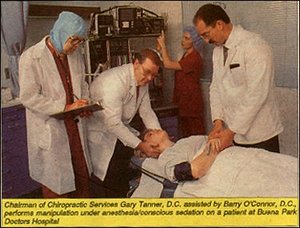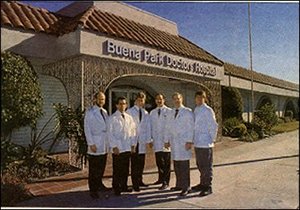
Whenever the telephone rings here at "DC," and every day when the mail comes, the air becomes energized by the prospect of news from within the profession.
One busy afternoon this past fall the telephone rang. On the line, a very enthusiastic speaker disclosed some information that jolted us with a wonderful discovery. Right here, in our own back yard (of Southern California) some significant chiropractic history had very quietly been taking place.
Within a matter of weeks, I was dispatched to personally visit the location where it was all taking place. Driving there, I marveled at the irony of my destination, for it was Buena Park Doctors Hospital in Buena Park, California. For many who embrace the concept of holistic and natural healing, the idea of an acute-care hospital setting for chiropractic patients is admittedly, paradoxical.
Within the next few hours, I would hear and see first-hand, the unparalleled accomplishments that can take place when dedicated professionals combine their talents and energies in utilizing a multi-disciplinary approach to best benefit a patient.
Early last year, (January 31, 1990 issue) "DC" was extremely proud to publish an article about Doctors Hospital East Loop and Airline Drive Doctors Hospital in Houston, Texas where a hospital administration and a handful of DCs implemented a successful, first-of-its kind program of manipulation under anesthesia/ conscious sedation (MUA/CS).
A short time before that article was published, Mr. Robert Trautman, another hospital administrator of rare vision with a keen appreciation for chiropractic, was already working closely with his hospital's medical staff.
A chiropractic protocol was established for this new innovative mode of treatment for chronic and acute pain sufferers. Chiropractors now have the ability to co-admit patients to the hospital. The insights and directions of each profession are now complimenting each other. The hospital -- Buena Park Doctors Hospital. Mr. Trautman had attempted the same program in another hospital five years earlier -- but his words and ideas fell on deaf ears. The Buena Park facility listened.
Aided by the strong dedication and guidance of Chairman of the Chiropractic Service, Gary Tanner, D.C.; chiropractic staff members G. Douglas Andersen, D.C.; Barry O'Connor, D.C.; Stephen C. Smith, D.C. (of La Mirada); Stephen W. Smith, D.C. (of Buena Park); Robert Thompson, D.C.; and Todd Russell, D.C., the diagnostic and educational doors swung wider. The medical and chiropractic staff relationship grew stronger. The development of the chiropractic program served to further advance the hospital's special services. Buena Park (BP) Doctors Hospital strove to find the most effective means to address a prescribed treatment course for a patient.
Not surprisingly, when this dedicated group learned what was happening in Houston they determined that a mirror program at Doctors Hospital in Buena Park could be of great benefit to their facility and their patients.
After a detailed and careful analysis, Buena Park Doctors Hospital eagerly sponsored the certification program for Manipulation Under Anesthesia/I.V. Conscious Sedation (MUA/CS) for its staff of chiropractors.
The program was presented by an acknowledged pioneer of the MUA/CS procedure, Stephen Capps, D.C., D.A.B.C.O., and sponsored by Texas Chiropractic College (TCC). Indeed, chiropractic history was once again being made. On September 24, 1990 two staff members of the BP Chiropractic Service, Gary Tanner, D.C. and G. Douglas Andersen, D.C. conducted the first-ever chiropractic manipulation under anesthesia/conscious sedation in a hospital in the state of California.

(l to r) Stephen Smith, DC (La Mirada); Robert Thompson, DC; Barry O'Connor, DC; Todd Russell, DC; Chairman of Chiropractic Services Gary Tanner, DC; and G. Douglas Andersen, DC are the chiropractic arm of BP Doctor's Hospital's multi-discipline approach.
A Manipulation Under Conscious Sedation Patient Profile
Candidates for the MUA/CS program are those persons who have received regular manipulation and other health discipline treatment over a sufficient period of time to obtain results, but show no improvement in symptoms, character, or range of motion. MUA/CS patients are often those who would otherwise be considered prime candidates for surgical intervention. Some indications for MUA/CS may include:
Nerve entrapment; chronic myositis; chronic fibrositis; anomalies with restricted motion following trauma; chronic muscle contracture; acute muscle spasm associated with subluxation; chronic productive arthritis (spondylosis, spondylarthritis, spondylarthrosis); lumbarization associated with chronic/acute pain; chronic disc changes; old compression fractures; or traumatic torticollis. Failed back surgery syndrome (FBSS) and often-accompanying spinal adhesions are also indicated for relief through MUA/CS.
The program protocol outlines a method to ensure coordinated medical and chiropractic treatment. Integrated medical care by the referring chiropractor, the physician and the MUA/CS specially trained chiropractor set the stage for successful treatment outcomes. MUA/CS candidates are thoroughly screened for appropriateness and subject to rigorous diagnostic testing; an in-depth patient history; physical examination; laboratory and radiographic examinations; hypo-mobility studies and electro-diagnostic studies. Once this battery of exams and testing has been completed to rule out the contraindicating pathologies or neurological dysfunctions, a personalized treatment plan is developed for the patient.
Who Has the Privilege?
The manipulations under anesthesia/conscious sedation are scheduled with the Surgery Department just as any surgical procedure. Actually visiting the surgical unit (from a non-patient perspective) leaves one with a very strong visual impression of what an achievement the MUA/CS program is. It is also a privilege. With a shine of pride in his eyes, Dr. Tanner explained exactly how the procedure takes place. He further explained how, the MUA/CS is an additional privilege that can only be performed by a chiropractor who has been granted that privilege. And the privilege may only be granted after certification and sufficient proctoring has been done by a certified chiropractor (or duly credentialed and privileged orthopedic surgeon or DO who exhibits previous training and expertise in manipulation) following:
- a minimum of six observations of spinal manipulation under conscious sedation and
- a minimum of six demonstrations of spinal manipulation under conscious sedation.
Who Wins?
A critical portion of the MUA procedure is the post-care program. Once again the treatment team; the referring chiropractor, the physician and the MUA/CS specially trained chiropractor coordinate a treatment plan. Patients receive carefully regimented post-procedure treatment. In addition to manipulation therapy; physical therapy, and stretching exercises, a nutritional regime is recommended for each patient.
For the acute and chronic pain patient caught in the never-ending cycle of pain, the MUA/CS treatment may be the open door to recovery. Sadly, when the patient's pain doesn't "go away," the patient may search for "any way" or "anything" to end his pain. The benefits derived from MUA/CS are appreciable. (The hospital is currently in the process of implementing a mini back-school where patients will learn pre and post-MUA/CS protocols.) The results are remarkable -- the benefits even greater. From the patient's point of view, the restoration of spinal mobility means a life restored.
Another virtue of the program espoused by these doctors is the climate of "referring without fear." It is not uncommon for DCs to be wary, if not fearful, of referring patients to another DC for specialized treatment, for fear they might "lose" the patient to the other practitioner. Actually the referring chiropractor is the champion of the treatment approach, providing the fullest and most complete picture of the patients's history. The referring chiropractor's influence determines the success of the treatment and post-care.
The financial and emotional benefits are a significant plus as well. By minimizing repeat outpatient manipulations the cost factor is greatly reduced. Buena Park Doctors Hospital's future is bright; a futuristic administrator, a strong medical staff, and a new team of incredible health care professionals are leading the way.
Debi Pugliese
Assistant Editor




